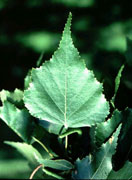


Home
Flowers &
Indoor Plants
Fruits & Nuts
Ornamentals
Vegetables
Special Topics
Resources
Glossary

|
Gray Birch; Clump Birch Betula populifolia (betch-yule-ah pop-yoo-li-fole-ee-ah)   Click on thumbnails for larger image. |
 |
What about it? The gray birch is a deciduous tree. Deciduous is a term that means these trees will lose their leaves every year. There are several different kinds of birch trees, but the gray birch is particularly popular because it has a beautiful white, papery bark Native Americans use the bark to make pouches and containers, or for writing and drawing. Birch trees are usually small and multi-stemmed. The leaves are 2-3 inches long, triangular and double toothed, or serrated, and they alternate with each other along the stem. Their seeds form into pendant clusters called catkins. What is it used for? Birches are handsome trees that are planted primarily for decoration. Their white bark will stand out from a backdrop of an ordinary green lawn. They will grow up to 50 feet tall and have a loose to open density. They tend to have an oval or irregular shape. If you are coordinating your fall colors, birch leaves turn a light yellow color, like margarine. Where does it grow? How do we grow it? Birches like sunshine so give them all they can get. Their roots will tolerate both dry, gravelly soil and very moist soil. The USDA winter hardiness number is 4, which means they will survive anywhere in New York. Birches should be planted 25 feet apart. If you need to move a birch tree, wait until spring and be sure to "ball and burlap" it. What are its primary problems? The #1 complaint about birches is that they don't live long enough. They are plagued by the dreaded Birch Leaf Miner and Bronze Birch Borer. The borer bores into tree trunks and kills them.
© Copyright, Department of Horticulture, Cornell University. |